- Exercise myths
- Exercise during pregnancy
- The family influence on exercise
- “Bulking up”
- Exercising during illness: Is there any truth to “sweating out a cold”?
- Exercise and weight loss
- Eating for exercise
- Exercise in the elderly
Exercise myths
Commonly we will find ourselves making excuses for skipping a walk or gym session after work; our joints hurt, it’s raining, we don’t want to get too bulky, or we feel a runny nose coming on….the list is endless. While we do need to listen to our bodies and give them rest when they need it is important to be able to identify when we should be pushing ourselves.
Our attitudes toward exercise are derived from a set of health beliefs. Our health beliefs define our behaviours and in this case the health behaviour is exercise. The motivation behind our exercise regimes will stem from:
- what we perceive is the “norm” for that behaviour;
- our risk perception of the behaviour (what we feel are the risks associated to our happiness, socialising and health);
- how much control we feel we have over that behaviour; and
- how we generally feel toward it.
Health beliefs vary greatly between individuals with different lifestyles and influences which is what separates the “gym junkies” from the “couch potatoes”. One thing that influences our health beliefs regarding exercise is the myths surrounding the area that are generally believed or unknown. It is important to understand the full and true benefits of exercise in order to extinguish the “barriers” between ourselves and exercise in order to change our health beliefs for the better.
Exercise during pregnancy
Many women are hesitant to engage in any sort of physical activity while they are pregnant, and rightfully so. Exercise has been believed to increase risks associated with pregnancies but many of these beliefs are unsubstantiated with no scientific proof. For example, studies have shown that moderate exercise is not a predisposing factor to spontaneous abortion, preterm labour or interuterine growth restriction.
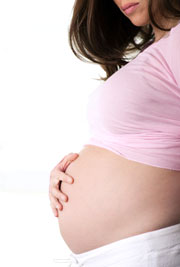
- More likely to experience shorter labours;
- Their babies are less likely to experience acute foetal distress during labour;
- Have a lower prevalence of abdominal and vaginal operations; and
- Have less pregnancy-related weight gain.
While the neonates of women who exercise while pregnant do appear to be smaller, this size difference is not associated with any clinically significant negative health consequences. Investigators have even suggested that this may reduce the possibility of obesity later in life.
Please be aware that these studies were conducted in a sample of women who were classified as having low risk pregnancies. The results cannot be generalised for all women and each case needs to be assessed individually. It is extremely important that you consult with your doctor and obstetrician before you engage in any sort of physical activity while pregnant. It is important to keep in mind that pregnant ladies should only engage in moderate intensity exercise for a limited duration.
 |
It is important to stay active during pregnancy to control weight gain, relieve stress and reduce muscle tension. Other exercises can strengthen abdominal and pelvic floor muscles.For more information, see Pregnancy and Exercise. |
Family influence on exercise
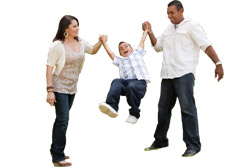
This can be very helpful if all family members work to encourage regular moderate exercise but this also goes the other way and can be quite destructive if one partner “gives up”. It is important then to remember what influence you will have on the people around you and if you want to make a positive change it will help you to help them. It will be easier to encourage your children to get out in the great outdoors and run around if you do it too. If your spouse is working hard to maintain a healthy exercise regime you can help by becoming more involved, this will have benefits for you and for your family.
“Bulking up”
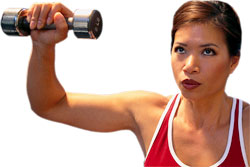
Secondly, individual muscle fibres will only enlarge when muscles are overloaded with weight which is not the aim for some weight bearing activities such as resistance training.
More information on Resistance Training.
More information on Resistance Training Exercises.
Exercising during illness: Is there any truth to “sweating out a cold”?
Whether to rest when sick or “sweat it out” is often a major cause of debate and the evidence for either is limited. The generally accepted belief in humans is that if the cold is limited to a runny nose and a sore throat moderate exercise is not harmful and performance does not appear to be affected though high intensity training should not be resumed until 1 to 2 days after symptoms have subsided.

Interestingly, bouts of exercise have been shown to improve immunity and reduce the long term risk of infection. The immune system responds to the short-term stress that is placed on the body during exercise. Furthermore, physical activity releases daily tension which in turn reduces overall life stress and therefore feeds back into a strong immune system. Just 30 minutes of moderate exercise 5 times a week has shown a significant reduced reporting of sickness and duration of sickness compared to no exercise.
Conversely, intense exercise has been shown to lower resistance to upper respiratory tract infections (URTI) and flu-like symptoms. The risk of contracting these common illnesses is especially increased in athletes during heavy training periods and after competitive events. Athletes who train hard but without overtraining are less likely to contract illness than those who overtrain in “bouts”.
Coaches and exercise trainers suggest that athletes should follow the following guidelines in order to avoid upper respiratory tract infection:
- Practice stress control in order to keep lifestyle stressors to a minimum
- Eat a well-balanced diet
- Avoid fatiguing the body through overtraining
- Make sure regular and adequate sleep is achieved
- Avoid rapid weight loss
- Avoid viral self-inoculation through putting hands near the face and mouth
Exercise and weight loss
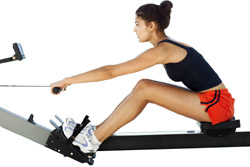
That said weight loss can be achieved by either restricting kilojoule intake alone or increasing exercise alone, though will be less effective. Initiating or increasing exercise without reducing kilojoule intake can reduce the amount of adipose tissue, importantly visceral abdominal adipose tissue and therefore will reduce insulin resistance.
Many people are mislead about different weight loss strategies and “fad” diets that are advertised. Adolescence appears to be the age group that is more likely to hold misperceptions regarding their weight and strategies to lose it. Adolescents tend to utilise risky weight loss strategies and have a higher incidence of mental health issues concerned with their weight loss. In a study surveying adolescent weight loss strategies less than 20% combined healthy diet with exercise while 15% only focussed on exercise and 25% only focussed on diet. Similar findings have been found in multiple studies. Adolescent weight is a good indication of weight in adulthood and as such is a time where developing good eating and exercising habits is very important.
Eating for exercise
A natural impulse after a big run is to prepare a large “guilt free” meal. The common and natural belief is “I went for a long run today so I can have pizza and icecream and it won’t matter”. Unfortunately this is not the case and this thinking can lead to weight gain.
The actual amount of food burnt off after one exercise session is overestimated. Cycling at a moderate intensity for 1 hour burns off approximately 1380 kilojoules or, put in take away terms, less than half a burger with cheese.
The amount of energy each individual requires in order to maintain their current weight is calculated using a number of variables unique to each person. The age, sex, weight and height is used to determine the amount of energy they require without taking into consideration any physical activity. This is called the resting energy expenditure (REE). This value is then multiplied by the physical activity level (PAL) score for the individual. The PAL score is dependent on lifestyle. A person who has a very sedentary lifestyle or light activity lifestyle will have a low PAL whereas those who regularly engage in strenuous activity will have a large PAL. The higher the PAL, the more energy will be required to maintain current weight. Going for a one-off run or swim will not change the PAL score and therefore will make a negligible difference to the energy required from foods. However, changing lifestyle behaviours from never exercising to regularly engaging in moderate to intense exercise will increase the energy “allowance” over time. Keep in mind that this greater energy allowance is not a gateway to junk food but rather a very slight increase in energy requirements that may be filled with one serve of carbohydrates (2 slices of bread) or less!
More information on Energy Expenditure.
Exercise and physical activity in the elderly
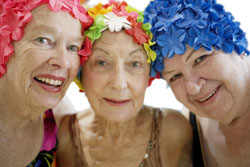
Attitudes toward exercise in older people are highly influenced by their self-identified fatigue and physical stressors such as muscle soreness and joint ache. Older people will avoid exercise for these reasons. However, what needs to be remembered is that physical activity does not need to be achieved through bouts of intentional exercise such as going for a walk or a swim. Often for the elderly a slight change in routine and lifestyle to incorporate more physical activity will have significant health benefits. For example, parking a bit further away from the shopping centre or using a shopping basket instead of a trolley for small shopping trips.
This is not to say engaging in intentional exercise will not have tremendous health benefits. Often the older people get, the more they enjoy the social aspect of exercising. Walking in the park with friends, water aerobics and lawn bowls can be fun. Social activities can take away the “effort” of exercise. In fact, older people who exercise regularly are encouraged more by the social side of exercise rather than the health benefits with many people reporting wanting to feel happy, see friends and engage in social contact rather than prevent osteoporosis or losing weight. These ideas can be incorporated into physical activity programs for older people.
More information on Weights Training in Older People.
More information
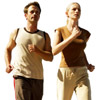 |
For more information on fitness and exercise, including stretches, types of exercise, exercise recovery and exercise with health conditions, as well as some useful videos, see Fitness |
References
- Jones EJ, Roche CC, Appel SJ. A review of the health beliefs and lifestyle behaviours of women with previous gestational diabetes. JOGNN. 2009; 38: 516-26.
- Magnann EF, Evans SF, Weitz B, Newhham J. Antepartum, Intrapartum, and Neonatal Significance of Exercise on Healthy Low-Risk Pregnant Working Women. Obstet Gynecol. 2002; 99: 466-72.
- Falba TA, Sindelar JL. Spousal concordance in health behavior change. Health Services Research. 2008; 43(1 Pt 1): 96-116.
- McArdle WD, Katch FI, Katch VL. Exercise Physiology: Energy, Nutrition, and Human Performance. 5th ed. Baltimore: Lippincott Williams & Wilkins; 2001.
- Hoffman J. Physiological Aspects of Sport Training and Endurance. New Jersey: Human Kinetics; 2002.
- Nieman DC. Current perspective on exercise immunology. Current Sports Medicine Reports. 2003; 2(5): 239-42.
- D’Arrigo T. Grant yourself immunity. 5 ways to keep healthy this cold and flu season. Diabetes Forecast. 2008; 61(12): 52-5.
- Bellar A, Jarosz PA, Bellar D. Implications of the biology of weight regulation and obesity on the treatment of obesity. Am Acad Nurse Practic. 2008; 20: 128-35.
- Mei-Yen, C Jun-Yu F, Sui-Whi J, Jen-Yu W. Do Overweight Adolescents Perceive the Need to Reduce Weight and Take Healthy Actions? J Nursing R. 2009; 17(4): 270-7.
- Heymsfield SB, Harp JB, Rowell PN, Nguyen AM, Pietrobelli A. How much may I eat? Calorie estimates based upon energy expenditure prediction equations. Obesity Rev. 2006; 7: 361-70.
- Conn VS. Older women’s beliefs about physical activity. Public Health Nursing. 1998; 15(5): 370-8.
All content and media on the HealthEngine Blog is created and published online for informational purposes only. It is not intended to be a substitute for professional medical advice and should not be relied on as health or personal advice. Always seek the guidance of your doctor or other qualified health professional with any questions you may have regarding your health or a medical condition. Never disregard the advice of a medical professional, or delay in seeking it because of something you have read on this Website. If you think you may have a medical emergency, call your doctor, go to the nearest hospital emergency department, or call the emergency services immediately.








